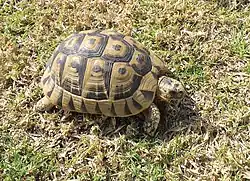سلحفاة
Arabic

Etymology
Probably derived from an unattested Aramaic form akin to Classical Syriac ܣܠܘܦܝܬܐ (sallōp̄īṯā), Hebrew שַׁלְחוּפָה (šalḥūp̄ā, “tortoise”), from Akkadian 𒃻𒅮𒈾 (šeleppûm, “turtle, snake; a shell, egg, canister”). Distortion of the Akkadian form in either Aramaic or Arabic after native roots such as س ل ح (s-l-ḥ), س ل خ (s-l-ḵ), and ز ح ل (z-ḥ-l) is likely, as with many terms for organisms encountered only at special occasions (see exemplarily Russian берескле́т (beresklét, “spindle tree”)); Arabic vernaculars offer forms like سُحَلْفَاة (suḥalfāh), زُلَحْفَاة (zulaḥfāh), زَحَلْفَة (zaḥalfa) and زِلَحْفَة (zilaḥfa), copiously found in the writings of the inerudite mass on the internet. Compare the variants of سَرَطَان (saraṭān, “crab”) for a similar case, as well as سِحْلِيَّة (siḥliyya, “lizard”), with which it may have been confounded in one or the other dialect area.
Pronunciation
- IPA(key): /su.laħ.faːh/
Noun
سُلَحْفَاة • (sulaḥfāh) f (plural سَلَاحِف (salāḥif))
Declension
| Singular | singular triptote in ـَاة (-āh) | ||
|---|---|---|---|
| Indefinite | Definite | Construct | |
| Informal | سُلَحْفَاة sulaḥfāt |
السُّلَحْفَاة as-sulaḥfāt |
سُلَحْفَاة sulaḥfāt |
| Nominative | سُلَحْفَاةٌ sulaḥfātun |
السُّلَحْفَاةُ as-sulaḥfātu |
سُلَحْفَاةُ sulaḥfātu |
| Accusative | سُلَحْفَاةً sulaḥfātan |
السُّلَحْفَاةَ as-sulaḥfāta |
سُلَحْفَاةَ sulaḥfāta |
| Genitive | سُلَحْفَاةٍ sulaḥfātin |
السُّلَحْفَاةِ as-sulaḥfāti |
سُلَحْفَاةِ sulaḥfāti |
| Dual | Indefinite | Definite | Construct |
| Informal | سُلَحْفَاتَيْن sulaḥfātayn |
السُّلَحْفَاتَيْن as-sulaḥfātayn |
سُلَحْفَاتَيْ sulaḥfātay |
| Nominative | سُلَحْفَاتَانِ sulaḥfātāni |
السُّلَحْفَاتَانِ as-sulaḥfātāni |
سُلَحْفَاتَا sulaḥfātā |
| Accusative | سُلَحْفَاتَيْنِ sulaḥfātayni |
السُّلَحْفَاتَيْنِ as-sulaḥfātayni |
سُلَحْفَاتَيْ sulaḥfātay |
| Genitive | سُلَحْفَاتَيْنِ sulaḥfātayni |
السُّلَحْفَاتَيْنِ as-sulaḥfātayni |
سُلَحْفَاتَيْ sulaḥfātay |
| Plural | basic broken plural diptote | ||
| Indefinite | Definite | Construct | |
| Informal | سَلَاحِف salāḥif |
السَّلَاحِف as-salāḥif |
سَلَاحِف salāḥif |
| Nominative | سَلَاحِفُ salāḥifu |
السَّلَاحِفُ as-salāḥifu |
سَلَاحِفُ salāḥifu |
| Accusative | سَلَاحِفَ salāḥifa |
السَّلَاحِفَ as-salāḥifa |
سَلَاحِفَ salāḥifa |
| Genitive | سَلَاحِفَ salāḥifa |
السَّلَاحِفِ as-salāḥifi |
سَلَاحِفِ salāḥifi |
Descendants
- → Mehri: salefḥōt
References
 سلحفاة on the Arabic Wikipedia.Wikipedia ar
سلحفاة on the Arabic Wikipedia.Wikipedia ar- Militarev, Alexander; Kogan, Leonid (2005) Semitic Etymological Dictionary, volume II: Animal Names, Münster: Ugarit-Verlag, →ISBN, pages 265–266 Nr. 202, tends towards cognateship, however deems the Syriac likely borrowed from Akkadian and the Mehri an Arabism (not considering the etymon of the Arabic just being lost, oddly also not mentioning the Hebrew form).
- Siddiqi, Abdussattar (1919) Studien über die Persischen Fremdwörter im klassischen Arabisch (in German), Göttingen: Vandenhoeck & Ruprecht, pages 72 interprets as Persian سولاخ (sulâx) ~ سوراخ (surâx, “hole opening”) + پا (pâ, “foot”)
- Wehr, Hans; Kropfitsch, Lorenz (1985), “سلحفاة”, in Arabisches Wörterbuch für die Schriftsprache der Gegenwart (in German), 5th edition, Wiesbaden: Otto Harrassowitz, published 2011, →ISBN, page 586